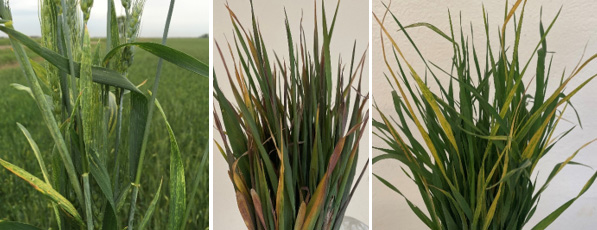Wheat Streak Mosaic Virus Information

Wheat Streak Mosaic (WSM) is a disease caused by the Wheat Streak Mosaic Virus (WSMV). The virus is vectored by the movement and feeding of the wheat curl mite (Aceria tosichella). Infected plants are usually stunted and produce fewer seeds, which are often badly shriveled. The earlier the infection, the greater the effect on the plant. Plants may die, fail to set seed, be stunted or show little effect, depending on when they were infected.
Most years, the virus and vector do not survive winter, so we do not often see early season symptoms in Alberta wheat fields. The most recent epidemic in Alberta was in 2017. In 2022, more than ten fields were confirmed in Southern Alberta. As of the end of June 2023, close to 20 fields are confirmed. The area currently reporting symptoms is South of the Red Deer River.
Scout for Symptoms
Producers, agronomists, and crop scouts are encouraged to watch for symptoms of WSMV on wheat (winter, spring, durum), barley, corn and all other cereals and grasses. Wheat is by far the most susceptible host, followed by barley, so these crops are most likely to have symptoms. Once wheat or barley becomes infected, symptoms may appear within a few days.
Initial symptoms include light green streaks parallel to leaf veins that discontinuously elongate to give a mosaic colouration, often alternating between chlorosis, pale green, and dark green. In severe cases, symptoms coalesce to form chlorotic areas and may even cause complete scorching and desiccation of leaves. On some hosts, a purple discolouration may appear. Symptoms may first appear at the field edge on volunteer wheat, or on winter wheat crops. At later stages, infected plants may become stunted, discoluored (lemon-yellow) and rosetted. If infection occurs before jointing, it can severely reduce or even prevent grain formation.
Get a Laboratory Confirmation
It is not possible to consistently diagnose WSMV infections based on the mosaic symptoms found on the leaves because these symptoms vary with the growth stage of the host, the virus concentration, and will often overlap with symptoms of other infections or deficiencies. As a result, laboratory confirmation using a molecular test is recommended. If you would like a sample assessed to confirm WSMV’s presence or absence, the Alberta Plant Health Lab is temporarily accepting samples. Please contact the APHL (AF.PHL@gov.ab.ca) for collection and submission information.
Management of WSM
The only in-season management option for severely infected fields is to harvest the crop early for silage or green feed. No in-season pesticides or other products exist that can manage WSMV. Fungicides do not kill a virus, and insecticides do not kill the mite. Miticide spray applications are ineffective because the mites are microscopic and reclusive – so they “hide” in crevasses, cracks or the underside of leaves to avoid contact with the miticide. If severe infections occur early in the growing season, it may be best to terminate the crop and reseed with a short-season broadleaf crop.
The best way to control WSMV is crop rotation and the prevention of “green bridge” hosts. “Green bridge” is a term referring to continuous green tissue available for the virus which provides a vector to “bridge” the spring crop to the fall-seeded, or winter, crop. The virus and vector cannot survive for more than a week or two without a green host. Preventing a “green bridge” will break the disease cycle and eliminate the problem for the next growing season. This is accomplished by controlling and managing cereal volunteers and, most importantly, by delaying the seeding of Winter cereals for at least two weeks after harvest of the Spring-seeded crop. This will create a two-week period with no green host tissue available to support WSMV’s survival. The result is that both the virus and mite vector die, and there is no bridge to the next growing season. Winter wheat and other fall-seeded cereals can still be grown, but delayed seeding is essential. Finally, a two-or-more year break between cereals is recommended.
More Information
Contact:
Dr. Michael Harding, Crop Health Assurance Lead, Alberta Agriculture and Irrigation
Contact Us
Saddle Hills
Junction of Hwy 49 & Secondary Hwy 725
RR1, Spirit River AB
T0H 3G0
T. 780-864-3760
Fax 780-864-3904
Toll-free 1-888-864-3760
frontdesk@saddlehills.ab.ca
Sign up to our Newsletter
Stay up to date on the Saddle Hills activities, events, programs and operations by subscribing to our eNewsletters.
